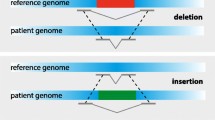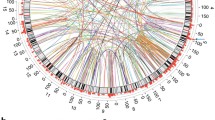Abstract
Cornelia de Lange syndrome (CdLS) is a rare, multiple congenital anomaly/mental retardation syndrome characterized by clinical variability and caused by mutations in the NIPBL (50–60%), SMC1L1 and SMC3 genes (5%), which encode for proteins involved in sister chromatid cohesion. Almost all of the studies of premature chromatid separation (PCS) in CdLS patients have failed to demonstrate that it is specific to CdLS, thus making its diagnostic use controversial. In order to verify the diagnostic usefulness of PCS screening in CdLS, we analysed metaphase spreads from 29 CdLS patients and 24 controls using a rigorous protocol to induce PCS, and precise criteria to score the affected chromosomes. Following exclusion of significant intra-sample variation we scored under blind conditions 150 spreads from a single preparation of each case and computed the ratio between the number of prematurely separated chromatids and the total number of chromatids. The results indicate the extreme variability of PCS in both cohorts (CdLS: mean 2.8 ± 2.8%; controls: mean 4.0 ± 5.4%) and highlight the difficulty of PCS monitoring, especially when selecting the control population. The absence of any difference in the frequency of PCS between the patients and controls, or between patients with different clinical or genetic backgrounds, precludes its potential use as an additional diagnostic tool.





Similar content being viewed by others
Abbreviations
- CdLS:
-
Cornelia de Lange syndrome
- CGH:
-
comparative genomic hybridization
- DHPLC:
-
denaturing high-performance liquid chromatography
- FISH:
-
fluorescence in-situ hybridization
- MLPA:
-
multiple ligation-dependent probe amplification
- MVA:
-
multiple variegated aneuploidy
- NIPBL :
-
Nipped-B-like
- PCS:
-
premature chromatid separation
- SCC2:
-
sister chromatid cohesion protein 2
- SMC:
-
structural maintenance of chromosomes
References
Barber TD, McManus K, Yuen KW et al (2008) Chromatid cohesion defects may underlie chromosome instability in human colorectal cancers. Proc Natl Acad Sci U S A 105:3443–3448
Brachmann W (1916) Ein Fall von symmetrischer Monodaktylie durch Ulnadefekt, mit symmetrischer Flughautbildung in den Ellenbeugen, sowie anderen Abnormitäten (Zwerghaftigkeit, Halsrippen, Behaarung) [A case of symmetrical monodactyly representing ulnar deficiency, with symmetrical antecubital webbing and other abnormalities (dwarfish, cervical ribs, hirsutism)]. Jahrbuch für Kinderheilkunde und physische Erziehung 84:225–235
de Lange C (1933) Sur un type nouveau de dégéneration (typus Amstelodamnesis) [On a new type of degeneration (type Amstelodamnesis)]. Arch Méd Enfants 36a:713–719
Deardorff MA, Kaur M, Yaeger D et al (2007) Mutations in cohesin complex members SMC3 and SMC1A cause a mild variant of cornelia de Lange syndrome with predominant mental retardation. Am J Hum Genet 80:485–494
Domínguez MG, Rivera H (1992) C-anaphases: a mitotic variant. Ann Genet 35:183–185
Dorsett D, Krantz ID (2009) On the molecular etiology of Cornelia de Lange syndrome. Ann N Y Acad Sci 1151:22–37
Gause M, Webber HA, Misulovin Z et al (2008) Functional links between Drosophila Nipped-B and cohesin in somatic and meiotic cells. Chromosoma 117:51–66
German J (1979) Roberts’ syndrome. I. Cytological evidence for a disturbance in chromatid pairing. Clin Genet 16:441–447
Gervasini C, Pfundt R, Castronovo P et al (2008) Search for genomic imbalances in a cohort of 24 Cornelia de Lange patients negative for mutations in the NIPBL and SMC1L1 genes. Clin Genet 74:531–538
Guacci V, Koshland D, Strunnikov A (1997) A direct link between sister chromatid cohesion and chromosome condensation revealed through the analysis of MCD1 in S. cerevisiae. Cell 91:47–57
Hanks S, Coleman K, Reid S et al (2004) Constitutional aneuploidy and cancer predisposition caused by biallelic mutations in BUB1B. Nat Genet 36:1159–1161
Ikeuchi T, Yang ZQ, Wakamatsu K, Kajii T (2004) Induction of premature chromatid separation (PCS) in individuals with PCS trait and in normal controls. Am J Med Genet 127A:128–132
Kajii T, Asamoto A (2004) Prenatal diagnosis of a heterozygous carrier of premature chromatid separation (PCS) trait. Am J Med Genet 126A:432
Kajii T, Kawai T, Takumi T et al (1998) Mosaic variegated aneuploidy with multiple congenital abnormalities: homozygosity for total premature chromatid separation trait. Am J Med Genet 78:245–249
Kaur M, DeScipio C, McCallum J et al (2005) Precocious sister chromatid separation (PSCS) in Cornelia de Lange syndrome. Am J Med Genet 138:27–31
Kline AD, Krantz ID, Sommer A et al (2007) Cornelia de Lange syndrome: clinical review, diagnostic and scoring systems, and anticipatory guidance. Am J Med Genet 143A:1287–1296
Krantz ID, McCallum J, DeScipio C et al (2004) Cornelia de Lange syndrome is caused by mutations in NIPBL, the human homolog of Drosophila melanogaster Nipped-B. Nat Genet 36:631–635
Mann MB, Hodges CA, Barnes E, Vogel H, Hassold TJ, Luo G (2005) Defective sister-chromatid cohesion, aneuploidy and cancer predisposition in a mouse model of type II Rothmund–Thomson syndrome. Hum Mol Genet 14:813–825
Méhes K, Bühler EM (1995) Premature centromere division: a possible manifestation of chromosome instability. Am J Med Genet 56:76–79
Méhes K, Kajtár P, Kosztolányi G (2002) Association of nonsyndromic Wilms tumor with premature centromere division (PCD). Am J Med Genet 112:215–216
Michaelis C, Ciosk R, Nasmyth K (1997) Cohesins: chromosomal proteins that prevent premature separation of sister chromatids. Cell 91:35–45
Moorhead PS, Heyman A (1983) Chromosome studies of patients with Alzheimer disease. Am J Med Genet 14:545–556
Musio A, Selicorni A, Focarelli ML et al (2006) X-linked Cornelia de Lange syndrome owing to SMC1L1 mutations. Nat Genet 38:528–530
Plaja A, Mediano C, Cano L et al (2003) Prenatal diagnosis of a rare chromosomal instability syndrome: variegated aneuploidy related to premature centromere division (PCD). Am J Med Genet 117A:85–86
Rao NM, Joshi NN, Shinde SR, Advani SH, Ghosh SN (1996) Premature separation of centromere and aneuploidy: an indicator of high risk in unaffected individuals from familial breast cancer families? Eur J Cancer Prev 5:343–350
Revenkova E, Focarelli ML, Susani L et al (2009) Cornelia de Lange syndrome mutations in SMC1A or SMC3 affect binding to DNA. Hum Mol Genet 18:418–427
Rollins RA, Morcillo P, Dorsett D (1999) Nipped-B, a Drosophila homologue of chromosomal adherins, participates in activation by remote enhancers in the cut and Ultrabithorax genes. Genetics 152:577–593
Rollins RA, Korom M, Aulner N, Martens A, Dorsett D (2004) Drosophila nipped-B protein supports sister chromatid cohesion and opposes the stromalin/Scc3 cohesion factor to facilitate long-range activation of the cut gene. Mol Cell Biol 24:3100–3111
Sari N, Akyuz C, Aktas D, et al. (2009) Wilms tumor, AML and medulloblastoma in a child with cancer prone syndrome of total premature chromatid separation and Fanconi anemia. Pediatr Blood Cancer Apr 16 [Epub ahead of print]
Scappaticci S, Cerimele D, Tondi M, Vivarelli R, Fois A, Fraccaro M (1988) Chromosome abnormalities in tuberous sclerosis. Hum Genet 79:151–156
Selicorni A, Russo S, Gervasini C et al (2007) Clinical score of 62 Italian patients with Cornelia de Lange syndrome and correlations with the presence and type of NIPBL mutation. Clin Genet 72:98–108
Shimura M, Tokunaga K, Konishi M et al (2005) Premature sister chromatid separation in HIV-1-infected peripheral blood lymphocytes. AIDS 19:1434–1438
Spremo-Potparević B, Zivković L, Djelić N, Bajić V (2004) Analysis of premature centromere division (PCD) of the X chromosome in Alzheimer patients through the cell cycle. Exp Gerontol 39:849–854
Spremo-Potparević B, Zivković L, Djelić N, Plećas-Solarović B, Smith MA, Bajić V (2008) Premature centromere division of the X chromosome in neurons in Alzheimer’s disease. J Neurochem 106:2218–2223
Strachan T (2005) Cornelia de Lange Syndrome and the link between chromosomal function, DNA repair and developmental gene regulation. Curr Opin Genet Dev 15:258–264
Tonkin ET, Wang TJ, Lisgo S, Bamshad MJ, Strachan T (2004) NIPBL, encoding a homolog of fungal Scc2-type sister chromatid cohesion proteins and fly Nipped-B, is mutated in Cornelia de Lange syndrome. Nat Genet 36:636–641
Van Allen MI, Filippi G, Siegel-Bartelt J et al (1993) Clinical variability within Brachmann-de Lange syndrome: a proposed classification system. Am J Med Genet 47:947–958
Vrouwe MG, Elghalbzouri-Maghrani E, Meijers M et al (2007) Increased DNA damage sensitivity of Cornelia de Lange syndrome cells: evidence for impaired recombinational repair. Hum Mol Genet 16:1478–1487
Acknowledgements
The authors thank the patients’ and the healthy controls’ families for participating in this study. In particular, they thank the Associazione Italiana di Volontariato Sindrome di Cornelia de Lange and the Mariani Foundation for their support and collaboration. This study was supported by grants from the Istituto Superiore di Sanità: ‘Rare Diseases’ Grant 526/A27 to L.L. (Istituto Auxologico Italiano) and ‘Rare Disease’ Grant to A.S. (Fondazione Ospedale Maggiore Policlinico, Mangiagalli e Regina Elena).
Author information
Authors and Affiliations
Corresponding author
Additional information
Responsible Editor: Wendy Bickmore.
Rights and permissions
About this article
Cite this article
Castronovo, P., Gervasini, C., Cereda, A. et al. Premature chromatid separation is not a useful diagnostic marker for Cornelia de Lange syndrome. Chromosome Res 17, 763–771 (2009). https://doi.org/10.1007/s10577-009-9066-6
Received:
Revised:
Accepted:
Published:
Issue Date:
DOI: https://doi.org/10.1007/s10577-009-9066-6




